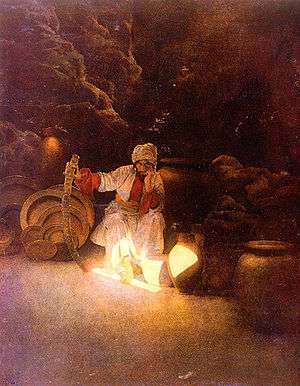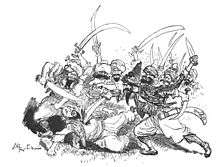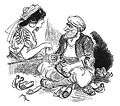Ali Baba

Ali Baba (Arabic: علي بابا ʿAlī Bābā ) is a character from the folk tale Ali Baba and the Forty Thieves (علي بابا والأربعون لصا). This story is included in many versions of the One Thousand and One Nights, to which it was added by Antoine Galland in the 18th century. It is one of the most familiar of the "Arabian Nights" tales, and has been widely retold and performed in many media, especially for children, where the more violent aspects of the story are often suppressed.
In the story, Ali Baba is a poor woodcutter who discovers the secret of a thieves' den, entered with the phrase "Open Sesame". The thieves learn this and try to kill Ali Baba, but Ali Baba's faithful slave-girl foils their plots. Ali Baba gives his son to her in marriage and keeps the secret of the treasure.
Textual history
The tale was added to the story collection One Thousand and One Nights by one of its European translators, Antoine Galland, who called his volumes Les Mille et Une Nuits (1704–1717). Galland was an 18th-century French Orientalist who may have heard it in oral form from a Middle Eastern story-teller from Aleppo, in modern-day Syria. In any case, the earliest known text of the story is Galland's French version. Richard F. Burton included it in the supplemental volumes (rather than the main collection of stories) of his translation (published as The Book of the Thousand Nights and a Night) and thought its origins were Greek Cypriot.[1]
The American Orientalist Duncan Black MacDonald discovered an Arabic-language manuscript of the story at the Bodleian Library;[2] however, this was later found to be a counterfeit.[3]
Story
Ali Baba and his elder brother Cassim are the sons of a merchant. After their father's death, the greedy Cassim marries a wealthy woman and becomes well-to-do, building on their father's business. Ali Baba marries a poor woman and settles into the trade of a woodcutter.
One day, Ali Baba is at work collecting and cutting firewood in the forest, and he happens to overhear a group of 40 thieves visiting their treasure store. The treasure is in a cave, the mouth of which is sealed by magic. It opens on the words "open sesame" and seals itself on the words "close sesame". When the thieves are gone, Ali Baba enters the cave himself and discreetly takes a single bag of gold coins home.
Ali Baba and his wife borrow his sister-in-law's scales to weigh their new wealth. Unbeknownst to them, Cassim's wife puts a blob of wax in the scales to find out what Ali Baba is using them for, as she is curious to know what kind of grain her impoverished brother-in-law needs to measure. To her shock, she finds a gold coin sticking to the scales and tells her husband. Under pressure from his brother, Ali Baba is forced to reveal the secret of the cave. Cassim goes to the cave, taking a donkey with him to take as much treasure as possible. He enters the cave with the magic words. But in his greed and excitement over the treasure, he forgets the words to get out again. The thieves find him there and kill him. When his brother does not come back, Ali Baba goes to the cave to look for him, and finds the body quartered and with each piece displayed just inside the cave's entrance, as a warning to anyone else who might try to enter.
Ali Baba brings the body home where he entrusts Morgiana, a clever slave-girl from Cassim's household, with the task of making others believe that Cassim has died a natural death.[4] First, Morgiana purchases medicines from an apothecary, telling him that Cassim is gravely ill. Then, she finds an old tailor known as Baba Mustafa whom she pays, blindfolds, and leads to Cassim's house. There, overnight, the tailor stitches the pieces of Cassim's body back together so that no one will be suspicious. Ali Baba and his family are able to give Cassim a proper burial without anyone's asking awkward questions.
The thieves, finding the body gone, realize that yet another person must know their secret, and they set out to track him down. One of the thieves goes down to the town and comes across Baba Mustafa, who mentions that he has just sewn a dead man's body back together. Realizing the dead man must have been the thieves' victim, the thief asks Baba Mustafa to lead the way to the house where the deed was performed. The tailor is blindfolded again, and in this state he is able to retrace his steps and find the house. The thief marks the door with a symbol so the other thieves can come back that night and kill everyone in the house. However, the thief has been seen by Morgiana who, loyal to her master, foils the thief's plan by marking all the houses in the neighborhood similarly. When the 40 thieves return that night, they cannot identify the correct house, and their leader kills the unsuccessful thief in a furious rage. The next day, another thief revisits Baba Mustafa and tries again. Only this time, a chunk is chipped out of the stone step at Ali Baba's front door. Again, Morgiana foils the plan by making similar chips in all the other doorsteps, and the second thief is killed for his failure as well. At last, the leader of the thieves goes and looks himself. This time, he memorizes every detail he can of the exterior of Ali Baba's house.
The leader of the thieves pretends to be an oil merchant in need of Ali Baba's hospitality, bringing with him mules loaded with 38 oil jars, one filled with oil, the other 37 hiding the other remaining thieves. Once Ali Baba is asleep, the thieves plan to kill him. Again, Morgiana discovers and foils the plan, killing the 37 thieves in their oil jars by pouring boiling oil on them. When their leader comes to rouse his men, he discovers they are all dead and escapes. The next morning, Morgiana tells Ali Baba about the thieves in the jars. They bury them, and Ali Baba shows his gratitude by giving Morgiana her freedom.
To exact revenge after some time, the leader of the thieves establishes himself as a merchant, befriends Ali Baba's son (who is now in charge of the late Cassim's business), and is invited to dinner at Ali Baba's house. However, the thief is recognized by Morgiana, who performs a sword dance with a dagger for the diners and plunges it into the thief's heart, when he is off his guard. Ali Baba is at first angry with Morgiana, but when he finds out the thief wanted to kill him, he is extremely grateful and rewards Morgiana by marrying her to his son. Ali Baba is then left as the only one knowing the secret of the treasure in the cave and how to access it.
Classification
The story has been classified in the Aarne–Thompson classification system as AT 676.[5]
In popular culture
Adaptations in art, entertainment, and media
Audio dramas
- In 1981, an audio musical play was produced in the Soviet Union. The play proved to be extremely popular (Over three million records were produced) and a movie was made, adding video to the existing soundtrack.
Books and comics
- Tom Holt's mythopoeic novel Open Sesame is based on characters from the story of Ali Baba and the Forty Thieves.
- Although not a direct adaptation, the characters of Ali Baba, Cassim, and Morgiana as well as part of the concept of the Forty Thieves are featured in the ongoing Japanese manga series Magi. In 2012, this manga was adapted to anime.
Films
- Ali Baba et les quarante voleurs is a 1902 short silent film directed by Ferdinand Zecca, and possibly the first film adaptation.
- Alibabavum 40 Thirudargalum is a 1941 Tamil film starring M. G. Ramachandran as Ali Baba.
- Ali Baba We El Arbeen Haramy (1942, in English" Ali Baba and the Forty Thieves) is an Egyptian movie adaptation, starring Ali AlKassar as Ali Baba and the comedian actor Ismail Yasin as his assistant.
- Ali Baba and the Forty Thieves (1944) was remade as The Sword of Ali Baba (1965). Frank Puglia portrayed the character named Kassim in both versions.
- Ali Baba et les quarante voleurs (1954) is a French film starring Fernandel and Samia Gamal.
- Alibabavum 40 Thirudargalum (1956, in English: Alibaba and Forty Thieves) is a Tamil film starring M. G. Ramachandran.
- Alibaba 40 dongalu (1970) is a Telugu film based on Ali Baba, starring N T Rama Rao and Jayalalitha.
- Ali Baba Bujang Lapok (1960) is a Malaysian comedy film which quite faithfully adhered to the tale's plot details but introduced a number of anachronisms for humour, for example the usage of a truck by Kassim Baba to steal the robbers' loot.
- Morgiana Abdulla (1970) is a Bengali film adaptation.
- Ali Baba ve Kırk Haramiler (1971, in English: Ali Baba and the Forty Thieves) is a Turkish movie, starring Sadri Alışık as Ali Baba.
- Ali Baba aur 40 Chor (1979), a Soviet-Indian joint film starring Dharmendra, Hema Malini, Rolan Bykov and Zeenat Aman, was largely based on this adventure tale.
- A Bollywood film Alibaba Aur 40 Chor (1980), starring Dharmendra, Hema Malini, and Zeenat Aman, was an Indo-Russian coproduction in which the original story line was slightly altered.
- Aladdin and the King of Thieves, an animated 1996 film partially borrows from the story, with several large differences.
- In the American/British television mini-series Arabian Nights (2000), the story is told faithfully with two major changes. The first is: when Morgiana discovers the thieves in the oil jars, she alerts Ali Baba and, together with a friend, they release the jars on a street with a steep incline that allows the jars to roll down and break open. Furthermore, the city guard is alerted and arrest the disoriented thieves as they emerge from their containers. Later, when Morgiana defeats the thief leader, Ali Baba, who is young and has no children, marries the heroine himself.
- Ali Baba (2007) is a French telefilm starring Gérard Jugnot and Catherine Zeta-Jones (2007).
- The story of Ali Baba was featured in Inkheart (2008). One of the 40 Thieves, named Farid (played by Rafi Gavron), is brought out of the story by Mortimer "Mo" Folchart and ends up becoming his ally.
Animated films
- A Popeye cartoon, Popeye the Sailor Meets Ali Baba's Forty Thieves (1937), features Popeye meeting and defeating the titular group and their leader Abu Hassan (portrayed by Popeye's nemesis Bluto).
- A Merrie Melodies Bugs Bunny/Daffy Duck cartoon, Ali Baba Bunny (1957), has a similar premise to the concept of the treasure-filled magical cave.
- The story was adapted in the 1971 anime Ali Baba and the Forty Thieves (アリババと40匹の盗賊 Aribaba to Yonjuppiki no Tozoku), storyboarded by Hayao Miyazaki.
- The Disney film Aladdin (1992) makes several references to the story.
- In Aladdin and the King of Thieves (1996), the 40 thieves play an integral part in the story. However, the story is very different from the original Ali Baba story, particularly Cassim's new role as Aladdin's father and the King of Thieves.
- In the anime Magi: The Labyrinth of Magic (serialized since June 2009), Ali Baba appears as one of the main characters and one of Aladdin's friends. At some point in the show, he is shown as the leader of a gang of thieves called Fog Troupe. Morgiana is his loyal friend, whom Ali Baba freed from slavery, and Cassim is his friend from the slums, who is constantly jealous of Ali Baba and tries to bring him ill fate, when he can.
Music
- The Beastie Boys reference Ali Baba in their song "Rhymin' and Stealin'" (1986).
- The second track on "super group" Dark Lotus' album Tales from the Lotus Pod (2001) is titled "Ali Baba".
Television
- Happily Ever After: Fairy Tales for Every Child televised a "gender bender" version of Ali Baba in 1999, featuring the voices of Jurnee Smollett as a female Ali Baba, Tommy Davidson as Cassim, Marla Gibbs as the Grandmother, Will Ferrell as Mamet the Moocher, George Wallace as Baba Mustafa, and Bruno Kirby as the Great One.
- In The Simpsons episode "Moe Goes from Rags to Riches" (January 29, 2012), Lisa is Scheherazade, who tells the story to Nelson Muntz as King Shahryar.
Theatre

- The story has been used as a popular pantomime plot for many years. An example of the "pantomime Ali Baba" was the pantomime/musical Chu Chin Chow (1916).
- 40 Thieves (1886) was a pantomime at the Royal Lyceum Theatre, Edinburgh.
- Ali-Baba (1887) is an opéra comique, with music by Charles Lecocq.
- Badi-Bandar Rupkatha (বাঁদী-বান্দার রূপকথা) is a 2014 Bangladeshi theatrical dance adaption of Ali Baba and Forty Thieves organised by Srishti cultural centre and Nrityanchal. Many leading Bangladeshi dancers performed in the adaption such as Shamim Ara Nipa, Shibli Sadiq, etc.[6]
Video games
- Ali Baba (1981) is a computer video game by Quality Software[7]
- Ali Baba and 40 Thieves (1982), is an arcade video game by Sega
- Elements of Ali Baba were featured in the second Dinosaur King series, from episodes 18 through 21. One of the most common elements of the story featured the 39 Thieves (one of its 40 members was out sick), and it featured the "Open Sesame" phrase.
- A version of Ali Baba appears in Sonic and the Secret Rings (2007), where he is portrayed by the character Tails.
- Ali Baba's Wee Booties can be found in the video game Team Fortress 2 (2007) for the Demoman.
- A gang of thieves known as the "Forty Thieves" appears in Sly Cooper: Thieves in Time (2013).
- In Puzzle & Action: Treasure Hunt, there is a character named Alibabaroa, who is a robber, and lives in Aden, the first level.
Business
- Alibaba Group of China used the name because of its universal appeal.[8]
Military
- At the United States Air Force Academy, Cadet Squadron 40 was originally nicknamed "Ali Baba and the Forty Thieves" before eventually changing its name to the "P-40 Warhawks".
Iraq war
The name "Ali Baba" was often used as derogatory slang by American and Iraqi soldiers and their allies in the Iraq War, to describe individuals suspected of a variety of offenses related to theft and looting.[9] Additionally, British soldiers routinely used the term to refer to Iraqi civilians.[10] In the subsequent occupation, it is used as a general term for the insurgents, similar to Charlie for the Viet Cong in the Vietnam War.[11]
The Iraqis adopted the term "Ali Baba" to describe foreign troops suspected of looting.[12]
Gallery
-

A depiction of the Forty Thieves.
-

The Forty Thieves attack Cassim.
-

A member of the Forty Thieves tries to discover the location of the house of Ali Baba.
-

A member of the Forty Thieves marks the door of Ali Baba
-

Morgiana pays Baba Mustafa the Cobbler.
-

Morgiana pours boiling hot oil into the jars containing the infamous Forty Thieves.
-

Ali Baba presents treasures from the magical cave of Sesame to Morgiana.
Notes
- ↑ Burton, R. F. Supplemental Nights to the Book of the Thousand Nights and a Night with Notes Anthropological and Explanatory. III, fasc. 2. p. 369. (n.)
- ↑ MacDonald, Duncan Black (April 1910). "'Ali Baba and the forty thieves' in Arabic from a Bodleian MS". Journal of the Royal Asiatic Society: 327–386. JSTOR 25189681.
- ↑ Mahdi, Muhsin (1994). "Galland's Successors (chapter 2)". The Thousand and One Nights: From the Earliest Known Sources, Part 3, "Introduction and Indexes".
- ↑ "Ali Baba or the 40 Thieves". Tapestrykinetics.com. Retrieved 2013-08-15.
- ↑ "Aarne thompson". Verhalenbank.nl. Retrieved 2013-08-15.
- ↑ "Leading Dancers to Present Ali Baba". Cinema.com.
- ↑ Barton, Matt (2007-02-23). "Part 2: The Golden Age (1985-1993)". The History of Computer Role-Playing Games. Gamasutra. Archived from the original on 30 March 2009. Retrieved 2009-03-26.
- ↑ "Alibaba’s IPO Filing: Everything You Need to Know - Digits - WSJ". blogs.wsj.com. Retrieved 11 July 2014.
- ↑ Vasagar, Jeevan. "Court martial hears of drowned Iraqi's final moments". Retrieved April 18, 2007.
- ↑ Norton-Taylor, Richard (September 21, 2009). "Baha Mousa inquiry: 'rotten' UK military blamed for death in army camp". Guardian.
- ↑ Fumento, Michael. "Back to Falluja: The Iraqi Army versus the Keystone Kops insurgency". Retrieved April 18, 2007.
- ↑ Levin, Jerry (May 3, 2003). "Will The Real Ali Baba Please Stand Up". CPT. Retrieved April 18, 2007.
External links
| Wikimedia Commons has media related to Ali Baba. |
- Ali Baba and the Forty Thieves (e-text, in English, at Bartleby.com)
- Ali Baba and the Forty Thieves at the Internet Movie Database
- Arabian Nights at the Internet Movie Database
- The Sword of Ali Baba at the Internet Movie Database